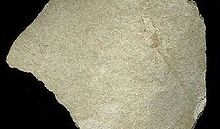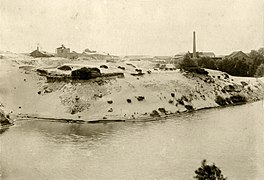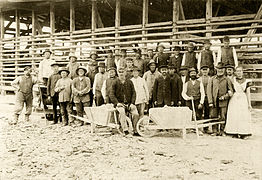Kieselguhr
Diatomaceous earth ( femininum , outdated also kieselguhr ) (also mountain flour, diatomaceous earth, Diatomeenpelit, diatomite, infusorial earth, silica flour, novaculite , triplet, Tripolit, Celite) is a whitish, powdery substance, consisting mainly of the shells of fossil diatoms (diatoms) consists.
The shells consist mainly of amorphous (non-crystalline) silicon dioxide (SiO 2 ) and have a very porous structure.
One milliliter of pure kieselguhr contains around a billion diatom shells and their fragments. "Gu (h) r" is a Low German popular expression meaning "moist, fermenting mass from the rock". From a geological point of view, kieselguhr is a sedimentary rock formed from fossil diatomaceous sludge , very finely layered it is called "triple".
Diatomaceous earth is a valued raw material and is used in a variety of ways.
Origin of occurrences
The kieselguhr deposits in northern Germany originated in the interglacial period and are several hundred thousand years old. The lakes' silicic acid water contained large amounts of diatoms of hundreds of different species. These diatoms, which still live in lakes and seas today, can reproduce every few hours by dividing the cells in two . It is estimated that under ideal conditions, one diatom can grow to one billion specimens in a month. These diatoms float in water, and after they die, they sink to the bottom and gradually form thick deposits. They later reach the surface of the earth through geological changes such as uplift.
The different types of kieselguhr
A distinction is made between saltwater kieselguhr and freshwater kieselguhr. The diatomaceous earth was deposited in three layers with different colors. The color of the kieselguhr results from the different content of residues of organic substances. The deeper the layers, the higher the proportion of organic components.
White Gur
The top layer is the "White Gur". Some of it is stored directly under the earth's surface. At three to five percent, it contains very few organic components. In the early years only the White Gur was dismantled.
Gray Gur
Under the White Gur lies the “Gray Gur”. It contains up to ten percent organic components. With the later introduced technique of burning these can be removed and the mining of the gray gur operated economically.
Green Gur
The lowest layer is known as the "Green Gur". It still contains around 36 percent organic components. Here you can still find prints of fish, as well as needles, cones and leaves from trees. The Green Gur was at the height of the water table.
Occurrence, use and mining
In 1836 or 1837, the farmer and freight carrier Peter Kasten is said to have discovered kieselguhr while digging a well on the northern slope of the Haußelberg in the Lüneburg Heath . At first it was believed to have found lime for fertilization. They also wanted to bake pancakes with it, as it resembled corn flour. Alfred Nobel used the properties of kieselguhr to produce dynamite . The Celle engineer Wilhelm Berkefeld recognized the filtering ability and developed the filter candles made from kieselguhr. This Berkefeld filter was successfully used during the cholera epidemic in Hamburg in 1892 .
Mining and storage sites in the Lüneburg Heath
- Neuohe, dismantling from 1863 to 1994 ( coordination of the dismantling areas)
- Wiechel from 1871 to 1978 (Coord. Of the mining areas)
- Hützel from 1876 to 1969
- Hösseringen from around 1880 to 1894
- Hammerstorf from around 1880 to 1920
- Oberohe from 1884 to 1970 (Coord. Of the mining areas)
- Schmarbeck from 1896 to approx. 1925
- Steinbeck from 1897 to 1928
- Breloh from 1907 to 1975 (Coord. Of the mining areas)
- Schwindebeck from 1913 to 1975
- Hetendorf from 1970 to 1994 (coordination of the mining areas)
The deposits were up to 28 meters thick. It is exclusively freshwater diatomaceous earth.
Up to the First World War , almost all global demand was met with diatomite from this region.
Other occurrences
In Germany, kieselguhr was also mined in Altenschlirf am Vogelsberg ( Upper Hesse ) and in Klieken ( Saxony-Anhalt ).
A kieselguhr layer up to four meters thick was also formed in the Soos nature reserve in the Czech Republic . There are deposits in Colorado and Clark County (Nevada) , USA, some of which are several hundred meters thick. In some deserts , kieselguhr is also found on the surface. The abrasion of diatomaceous earth on such surfaces (for example in the Bodélé Depression in the Sahara ) is one of the most important sources of climate-affecting dust in the atmosphere.
Open pit
The kieselguhr was extracted in open-cast mining. In the beginning, the kieselguhr was cut off by hand and transported out of the pit on wheelbarrows. It was later filled in carts that were pulled out of the pit by horses or winches. From the 1950s onwards, the wagons were pulled by locomotives. The dismantling was meanwhile done with backhoe excavators .
meaning
The world's first kieselguhr pits were located in the Lüneburg Heath. The kieselguhr mining, which took place from 1863, developed into an important industry for this region. Up to the First World War, 20,000 to 25,000 tons of diatomite were produced in Lower Saxony. At that time, that covered almost the entire world demand for this raw material. After World War II (1957), production reached 50,000 to 60,000 tons.
End of dismantling in Northern Germany
In 1994 mining in Northern Germany became unprofitable and stopped. The environmental requirements for the disposal of the seepage water were one of the causes. The pumped out water had a pH value of 3.8 to 4.8 and had to be brought to a pH value of 8.5 by adding soda and lime before it could be drained into the streams. As a result, the imported gur from the United States was now cheaper than the production costs of the native diatomite.
The rare marsh moose has now settled here
processing
1. Sludge
The diatomite obtained contained up to 30 percent sand. The kieselguhr had to be desanded in a slurry process. To do this, it was dissolved into a thin paste in a mixing vat. This flowed through several basins, in which the heavy sandy components settled. The kieselguhr, freed from sand, got into sludge boxes and settled here. The slurry was then tapped and dried.
2. Drying
The extracted diatomaceous earth contained up to 70 percent water and could therefore not be used as such. It had to be dried down to the usual ten percent. The Gur was partly shaped into stones in a press. This was followed by drying in the air, in drying areas or in drying sheds. This drying was only possible in the summer months. The duration depended decisively on the weather conditions. The first artificial drying of kieselguhr took place in the war years 1917/18 near Altenschlirf in Vogelsberg , today part of the Herbstein spa . Diatomaceous earth was needed for the filters in the gas masks .
3. Burning
The diatomaceous earth was in meiler-like internal clusters (similar to the wood charcoal pile ) or in internal shed, at most 800 ° C , fired. The average burn time was three to four weeks. The firing removed the organic components. It also changed color due to the iron oxide contained in the diatomaceous earth.
The "gray gur" showed a whitish to pure white color, the "green gur" took on a yellowish, light pink to reddish color because of its high content of iron oxide. During the burning process, foul-smelling vapors containing sulfuric acid escaped.
Processing by ovens
Shaft furnace
The shaft furnaces consisted of three meter long shafts into which 230 ° C hot air was blown from below through the kieselguhr. The organic substances and the iron were only partially removed. A “Acid Schachtofen-Gur” with a pH below 7 was obtained.
Deck oven
These ovens consisted of eight different floors.
- The gur was dried on the first four floors.
- On the next two floors it was burned at 600 to 800 ° C.
- The kieselguhr was cooled on the last two floors.
Wind sifting
Part of the kieselguhr, for example the Gur, which should be used for filtration, was wind sighted . Sand and other coarse particles were removed by a stream of air.
properties
- high absorbency
- low specific weight
- poor conductor of heat
- Fire and acid resistance
- high filter properties
- natural biocide
- stabilizes dispersions
use
Diatomaceous earth can be used in many ways, including as
- Filter medium for waste water , beverages such as light beers, oils or in swimming pools
- Filler in thermal insulation, building materials, paints , plastics , paper , tablets and powders
- Abrasives and polishes
- Abrasive in cleaning agents
- in animal feeding
- Carriers for fertilizers , biocides , insecticides and catalysts .
- Extraction aid (Extrelut) for lipophilic components from primarily aqueous test material ( urine , serum , milk , waste water , etc.) in chemical analysis
- Means for killing mites, fleas and the like a. in chicken farming; is also recommended against lice, ticks, cockroaches, beetles, ants, silverfish, ear pikers and snails.
- Agents for killing bed bugs
It is also used in dentistry, among other things as a component of impression materials such as alginate. Here it serves as a filler and increases the material strength after the rows of teeth have been molded. Diatomaceous earth is valued as a natural pesticide in organic agriculture, for example by chicken keepers ( mite control ): The fine fragments of shell are said to cause mechanical damage, for example in the digestive tract of insects and mites, and lead to dehydration.
If the vibration- sensitive nitroglycerine is mixed with diatomaceous earth, the result is dynamite , which is insensitive to impact and is therefore also referred to as "Gurdynamite" in older literature. It was through this invention that Alfred Nobel made his fortune. Since the kieselguhr does not take part in the explosion reaction (it is not flammable), it was replaced in the dynamite production with more suitable substances that can actively participate in the explosion (e.g. collodion wool ).
The addition of kieselguhr increases the resistance and weather resistance of the asphalt , and car tires become more abrasion-resistant and more temperature-resistant. In the case of paints and varnishes, the addition of diatomaceous earth prevents the pigments from settling on the floor after a period of storage. The addition of kieselguhr makes cement, mortar and concrete more plastic and processing is made easier.
In the case of fertilizers , this prevents the fertilizer grains from sticking together.
In margarine and fat production, kieselguhr is used as a carrier for the catalyst.
In horses, diatomaceous earth can help to reduce the chafing of the tail and mane in summer.
Dissous gas bottles for storing ethyne dissolved in acetone , for example the acetylene bottles used in autogenous welding, used to contain carcinogenic asbestos , but today they contain kieselguhr as a porous mass.
Due to its pore-rich structure, kieselguhr is ideally suited as a filtration medium to disinfect (drinking) water, remove turbid and suspended matter and hold back bacteria. For example, it is used in breweries to filter beer .
Many oil binders are based on diatomaceous earth.
- Arsenic exposure
In April 2013 it became known that Munich researchers had solved the mystery of the increased arsenic levels in German clear beers. The arsenic value is higher in some varieties than in the water used because, on the one hand, suspended matter is retained during the filtration , and on the other hand, the arsenic that is bound there is often transferred into the now crystal-clear alcoholic drink. Since the amounts involved are very small, there is no health risk. In the future, diatomite should be rinsed more frequently with water for filtering.
literature
- Karl-Heinz Grotjahn: The kieselguhr - the white gold of the heather. What the Lüneburg Heath has to do with the Nobel Prize. In: Home calendar 2003 for the Lüneburg Heath. Celle 2002, pages 28-33.
- Franz Kainer: Kieselguhr, its extraction, refinement and application. Collection of chemical and chemical-technical lectures NF 32. Stuttgart 1951.
- Ute Leimcke-Kuhlmann: Living and working in the kieselguhr works. In: Home calendar 2003 for the Lüneburg Heath. Celle 2002, pages 34-35.
- H. Müller: Pollen analysis and annual shift counts on the Holstein-temporal diatomaceous earth from Munster-Breloh. In: Geological Yearbook Series A. 21, 1974, pp. 107-140.
- H. Müller: Pollen analysis and annual shift counts on the Eemzeit diatomaceous earth from Bispingen / Luhe. In: Geological Yearbook Series A. 21, 1974, pp. 149–169.
- Volker Probst: Dreamland. Albert König's depictions of the Kieselguhr pits near Unterlüß and his last landscape paintings. Albert-König-Museum , Unterlüss 1994/95 (exhibition catalog)
- Rudolf Auth: The kieselguhr deposit of Steinfurt-Altenschlirf in the Vogelsberg. In: Beech leaves - supplement of the Fuldaer Zeitung for friends of home. No. 3 of February 24, 2015, pages 9–11 and No. 4 of February 25, 2015, pages 14–16.
Web links
- "Kieselguhr - The Adventure Exhibition" on the website of the Albert König Museum
Individual evidence
- ^ Ulrich Lehmann: Paleontological Dictionary. 4th edition. Enke, Stuttgart 1996, ISBN 3-432-83574-4 .
- ↑ Work of the qualified biologist Ute Leimcke-Kuhlmann, supported by Dr. Brigitte Urban , University of Applied Sciences North-East Lower Saxony in Suderburg.
- ↑ Florian Klebs: Germany cradle of the Nobel Prize. In: Humboldt Kosmos. January 21, 2001.
- ^ Heinrich Küsel: The memory. 1930.
- ↑ Kirsten Wagner: Lüneburg Heath with children: 300 exciting excursions into the natural paradise between Hamburg and Hanover . pmv Peter Meyer Verlag, 2015, ISBN 978-3-89859-082-2 , p. 151 ( books.google.de ).
- ↑ Former kieselguhr pit near Steinfurt-Altenschlirf .
- ↑ History of kieselguhr mining in Klieken ( Memento from June 21, 2006 in the Internet Archive ).
- ↑ Franz Kainer: Kieselguhr, its extraction, refinement and application . F. Enke, 1951, p. 4 ( books.google.de ).
- ^ Klaus Bötig: DuMont travel paperback travel guide Lüneburg Heath . Mair Dumont DE, 2015, ISBN 978-3-7701-8849-9 , pp. 78 ( books.google.de ).
- ↑ Industrial hygiene and the clinic of diatomaceous earth: at the same time a contribution to industrial hygiene of dusts that are aggressive to the lungs . Springer-Verlag, 2013, ISBN 978-3-642-86861-0 ( books.google.de ).
- ↑ Anja Steinhörster: Travel Guide Lüneburg Heath: Left and right of the Heidschnuckenweg . Koehlers Verlagsgesellschaft, 2015, ISBN 978-3-7822-1455-1 ( books.google.de ).
- ↑ Kieselguhr to control and prevent mites
- ↑ Kieselguhr, application examples in animals
- ↑ Bed bug problem , Die Zeit: bed bugs
- ↑ Oil binding agent
- ↑ cf. Tagesspiegel from April 9, 2013, p. 24.











